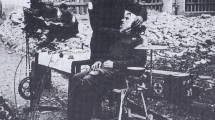Key Points
-
Birmingham Dental Hospital has been based at seven locations since it was founded in 1858.
-
The dental hospital and school moved to state-of-the-art new facilities in Pebble Mill this year.
-
The author of this article reflects on the history of the 'world's oldest dental school'.
Abstract
A look at the history of Birmingham Dental Hospital which, since it was first founded in 1858 as Birmingham Dental Dispensary, has moved six times, the sixth move being to its new Pebble Mill site on 1 April 2016.
Similar content being viewed by others
A historical perspective
Birmingham Dental Hospital was founded in January 1858 at Odd-fellows Hall, 13 Temple Street and it is now the oldest institution of its kind in the UK and it is believed in the world. The hospital was first called the 'Birmingham Dental Dispensary', and was founded by Samuel Adams Parker, son of the well-known Birmingham surgeon S. W. Langston Parker. It has moved six times between 1858 and 2016. The first move was in 1863 to number 2 Upper Priory, premises that were shared with the city's Homeopathic Hospital. The second relocation was in 1871 to number 9 Broad Street; Broad Street is now the cultural centre of the city located by the intersection of Birmingham's canals at Gas Street Basin and home to the International Convention Centre and the Symphony Hall. Interestingly, in 1882 the Dental Hospital occupied its fourth site at 71 Newhall Street, another city centre site and a short 5-minute walk from all three former sites. Here, it did not occupy the whole building, the cellars being let to a brewery; one can only imagine what happened on Friday evenings! The old Newhall Street hospital had a fearsome exterior (Fig. 1a) and the smokers in the enclosed surgery (Fig. 1b) would clearly not pass one of today's CQC or HSE inspections. Indeed, they would likely be the subject of a GDC fitness to practise investigation!
In 1905 Birmingham's Dental Hospital moved to 132 Great Charles Street, yet another city centre site and once more a 5-minute walk from its predecessors. The so-called 'East Filling Room' looks distinctly state-of-the-art with a beautiful wall of sky lights and a polyclinic atmosphere reminiscent of modern day dental hospitals (Fig. 2a). However, the so-called 'anaesthetic and operating room' did not appear quite as welcoming an environment as the filling room (Fig. 2b).
The Hospital remained in Great Charles Street for 59 years and in November 1964 after ten years of planning it moved to the St Chad's Queensway site, and at a cost of £2 million it was officially opened on 13 April 1965. Guess what? The St Chad's site was also a city centre location and a 10-15-minute walk from Temple Street, Upper Priory, Broad Street, Newhall Street and Great Charles Street.
Almost exactly 51 years later and on the auspicious day of 1 April 2016, the newest dental hospital and school in Europe, if not the world, opened its doors at Pebble Mill to patients for the first time. Some would argue a certain irony to the operational start date of 1 April, as the official opening by Her Majesty the Queen was on 19 November 2015, some five months earlier, but modern day snagging takes time. The current site is a stunning green field site in leafy Edgbaston, also home to Warwickshire and English cricket, and for the first time in our history it is not in the city centre and not a 5-minute walk from the six former sites. The new dental school/hospital has completed its maiden over very successfully and we sincerely hope that it will make yet another half century before there is a need to consider a further re-location (Figs. 3a-e). The facilities are second to none, with cutting edge and paper free clinical training, the highest specification for staff and student surgeries (12 m2), a stunning learning environment with on-site traditional and e-library facilities that feel more like your living room. Lecture theatres, seminar rooms and tutorial rooms boast the very best of blended IT options, and stunning research laboratories cover all aspects of biological and biomaterials research, all forms of microscopy, molecular and cell biology. There are clinical trials facilities on two floors and on-site production and clinical skills laboratories and classrooms for modern wet and dry laboratory work. The staff restaurant and coffee bars offer typical refreshments and patients log their attendance via electronic auto-registration booths. Oh – and there is plenty of car parking. The building embraces 15,456 m2 of contemporary space, larger than its former site, and has a tranquillity garden with small babbling brook, and views of trees rather than the A38 flyover at St Chad's.
The oldest dental education in the world and now the most modern
What of Birmingham Dental School's pedagogical pedigree? There were arrangements for the admission of medical and dental students to the hospital as early as 1878, but the Dental School was not formally constituted until 1880 at Queens College. The School was approved by the Royal College of Surgeons in 1881 and transferred to Mason's College in 1882, when three dental professorships were created. Mason's College became Birmingham University in 1900, and Birmingham University was the first in the UK to grant dental degrees. Today the Hospital is in its 158th year and the School in its 136th year, having eight full-time dental professorships. It runs a BDS programme for 355 dental students, has a BMedSci programme in biomaterials science (24 students per year), two master's programmes, one in advanced general dental practice and a new distance masters in the same, with another in restorative dentistry planned for September 2017. The University/School also accredit a BSc in Dental Hygiene and Therapy (30/year three years) run by the Hospital, which also runs a two-year dental nursing programme. Of course, we also vocationally train specialists and early career academics and NHS staff in all dental disciplines. There are 30 consultants, 200 dental nurses and 152 dental chairs, with several outreach facilities around the Midlands.
However, dental schools are about student education and learning and Birmingham Dental Student's Society (BUDSS) is also one of the oldest in the world, first meeting in 1886 130 years ago. Figures 4a & b show menus from the 1st Annual Dinner. The first students graduated from the new School and Hospital in July 2016, some 135 years after the Royal College approval of the first Dental School in Birmingham.
The last day in St Chad's – A personal reflection
As I tied the last suture and saw my patient to the surgery door, it suddenly occurred to me that I'd probably just completed the last ever surgical procedure at Birmingham Dental Hospital, St Chad's Queensway, B4 6NN. I glanced back at the 23-surgery clinic I'd designed in 1997, opened by Baroness Knight of Collingtree, every detail down to the location of each 13 amp socket and Xray viewer carefully planned. I wandered slowly to my empty office, to be faced by 13 packed crates, an empty desk and book shelves, and stood for the last time at the window of office number 274 looking out across the A38 Aston Expressway as the Thursday evening traffic snaked its way towards Spaghetti Junction and dusk fell (Figs 5a-c). Not the best view from an office, but it was my view and had been for the last 20 years; window sill covered in black soot as always, goodness knows what the leaky windows had let through and my lungs had faithfully taken custody of over so many years. A glance backwards and I closed the office door for the last time, leaving the key in the lock as I'd been instructed to do. Along the corridor and down four flights of stairs carrying my office plant to the car; I couldn't leave that behind, it had survived 20 years of neglect, the slops from my tea cup, yet its drive to survive and flourish was strong and it kept the CO2 levels down in my office. I said goodnight to Jeff and Neil, two of our fantastic porters, and walked to the car. One last look at the nine-floor T-shaped hospital, lit up like a hundred TV screens, each displaying a different channel, each channel the highlights of a different year; a living history of the old place, with so many stories to tell, so many lives that had been affected and over three and a half thousand dental students that had trained there and graduated over its 52 years of service (Fig. 6).
The journey to the new building, an equally iconic venue, rising up from the earth that had once supported the foundations of the famous Pebble Mill BBC studios was only two miles. The new address however masks the history, '5 Mill Pool Way, Edgbaston, Birmingham B5 7EG', no mention of Pebble Mill. Security let me in at 7.30 pm to deliver my plant to the new office on the top floor of this stunning piece of architecture, more a modern day shopping arcade in its ambiance than a dental hospital.
So at 158 years of age the 'Peter Pan' that is claimed to be the oldest dental hospital in the world had re-invented itself once more, 7 different addresses between 1858 and 2016, but this one is the first outside the city centre, in the beautiful leafy suburb of Edgbaston, home to the Queens Tennis tournament. A new chapter in the history of dentistry in the Heart of England begins and this article provides just a few snap shots of its pedigree.
Conclusion
So a vignette of dental history, and some personal reflections, which I suspect has surprised a few, it surprised me when I started researching the history of this wonderful establishment. It is important to acknowledge the drive and resolve of Philip Lumley my predecessor, my NHS colleagues including the former Medical Director Rick Roberts whose vision the new Hospital and School was, but who retired before the first brick was laid, and my academic colleagues who collectively made this happen. The new Hospital and School is a 'LIFT Project' and it is the NHS who pay the annual rental to the LIFT company via SIFT income; money well spent and an investment in the future dental workforce of the Midlands, the UK and indeed further afield. Come and visit us if you get the chance, it is a very friendly and welcoming atmosphere, and not a bad view from the top floor either of the 'Old Joe' clock tower in Chancellor's Court of the University (Fig. 3b), in memory of its founder Joseph Chamberlain. Incidentally, 'Old Joe' is the tallest free standing clock tower in the world, 329 ft high (100 metres), a clock dial measuring 17 ft in diameter, the length of the clock hands are 10 ft and 6 ft, and the bell weighs 5 tons; just one more small but important piece of academic history. (https://en.wikipedia.org/wiki/Joseph_Chamberlain_Memorial_Clock_Tower)
Author information
Authors and Affiliations
Corresponding author
Additional information
Refereed Paper
Rights and permissions
About this article
Cite this article
Chapple, I. Birmingham's new dental school and hospital – A real Peter Pan of dentistry. Br Dent J 221, 355–357 (2016). https://doi.org/10.1038/sj.bdj.2016.687
Accepted:
Published:
Issue Date:
DOI: https://doi.org/10.1038/sj.bdj.2016.687









